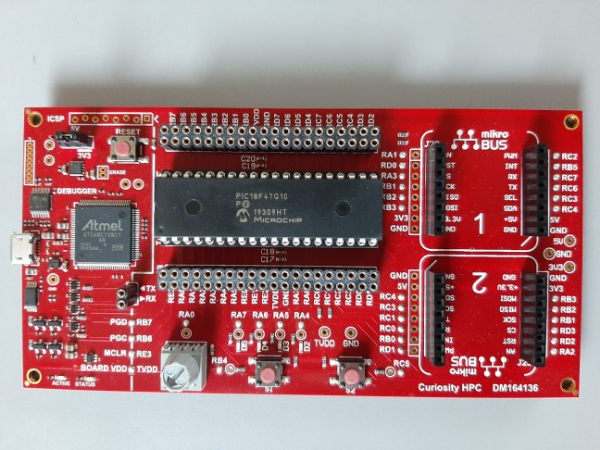Software Tools
MPLAB X IDE
This training was developed with MPLAB® X IDE version 5.45.
XC8 Compiler
This training was developed with XC8 Compiler version 2.31.
MPLAB Code Configurator (MCC)
This training was developed with MCC Plugin version 4.0.2.
As we are continuously improving the capabilities and features of our tools, the current versions of these tools will likely be different from those that were used to develop this exercise. In most cases the newer tools will be compatible with the exercise, but if you find you are having trouble, we recommend you use the same version as the developers did. Every version of our tools can be found on the archive section of each development tool webpage.
Hardware Tools
The Curiosity HPC board with integrated programmer/debugger is used for the project(s). It includes a PIC18F47Q10 MCU.
PIC18F47Q10 MCU
PIC18F47Q10 MCU is optimized for robust, real-time control and sensor nodes with integrated intelligent analog, configurable peripherals, and 5 V operation for increased noise immunity. They are well suited for a broad range of applications including industrial control, consumer, automotive, touch sensing, and Internet of Things (IoT). These 40/44-pin devices deliver Core Independent Peripherals such as CLC, CWG, WWDT, CRC/Memory Scan, Hardware CVD, Zero-Cross Detect, and Peripheral Pin Select, providing for increased design flexibility and lower system cost.
Curiosity HPC Development Board (DM164136)
The Curiosity High Pin Count (HPC) Development Board is one of the variants of Curiosity boards from Microchip. It supports 28- and 40-pin 8-bit PIC® MCUs. Two unique Plastic Dual In-line Package (PDIP) sockets are surrounded by dual-row expansion headers, which allow for connectivity to all pins on PIC MCUs. Programming/debugging is accomplished through the PICkit™ On Board (PKOB), eliminating the need for an external programming/debugging tool. The development board includes a set of four indication LEDs, a potentiometer, and push-button switches. Additionally, the Curiosity HPC Board integrates two MikroElektronika microBUS™ sockets, which accommodate a variety of plug-in Click™ Board modules that can be used for application development.

Purchase Here:

